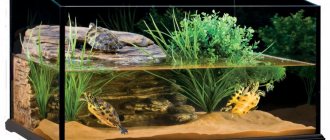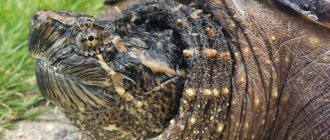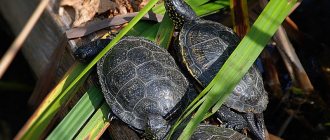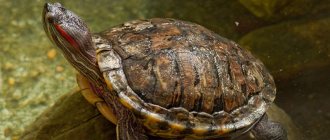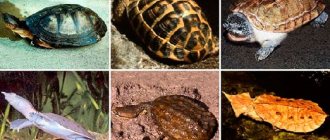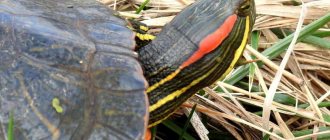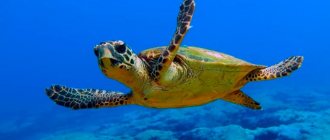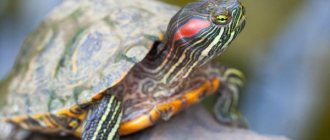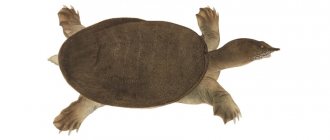The green turtle is considered one of the largest sea turtles. Its second name is “soup” turtle, which speaks for itself. Many travelers put a lot of effort into exploring the New World and the Caribbean Sea, while they massively exterminated these marine inhabitants, setting off on journeys to discover new lands.
Turtles were destroyed in large numbers to replenish food supplies. Their dried and dried meat was loaded onto ships. Soup was prepared from this meat. The soup made from these turtles is considered a delicacy even today. This is why green turtles are now on the verge of extinction.
Description of the green turtle
The largest sea turtles are very beautiful in their natural environment, when they graze in dense algae in coastal waters or cut through the surface of the water with powerful front paws equipped with flippers. A huge shell of green or brown and yellow scutes perfectly camouflages and protects them from predators .
Appearance
The rounded shell of the green turtle has an oval shape. In adult individuals, it can reach a record length of 2 meters, but the usual average size is 70 - 100 cm. The structure of the shell is unusual: it consists entirely of scutes adjacent to each other, has a more intense color on top, and is covered with scutes and has a small reptile head. The eyes have round pupils, are quite large and almond-shaped.
This is interesting! Flippers allow turtles to both swim and move on land; each limb has a claw.
The weight of an average individual is 80-100 kg, and specimens weighing 200 kg are not uncommon. But the record weight of a green sea turtle is 400 and even 500 kilograms. The color of the shell depends on the place where the turtle was born and grows. It can be either a swamp, dirty green color, or brown, with uneven yellow spots. But the skin and the fat that accumulates under the shell on the inside have a green tint, thanks to which turtle dishes also have a special taste.
Behavior, lifestyle
Sea turtles rarely live in colonies; they prefer a solitary lifestyle. But for several centuries now, researchers have been baffled by the phenomenon of sea turtles, which are perfectly oriented in the directions of the currents of the deep sea and are able to gather on one of the beaches on a certain day in order to lay eggs.
After several decades, they are able to find the beach where they once hatched, and it is there that they will lay their eggs, even if they have to travel thousands of kilometers.
Sea turtles are non-aggressive, trusting, and try to stay near the shore, where the depth does not reach 10 meters . Here they bask on the surface of the water, can climb onto land to sunbathe, and eat algae. Turtles breathe through their lungs, inhaling it every 5 minutes from the surface.
But when at rest or asleep, green turtles may not emerge for several hours. Powerful forelimbs - flippers, more like oars, help them move at speeds of up to 10 kilometers per hour, so green turtles are quite good swimmers.
The babies, barely hatched from the eggs, rush across the sand to the water. Not everyone manages to get even to the surf line, since birds, small predators, and other reptiles and reptiles prey on the crumbs with soft shells. Babies on the shore are easy prey, but they are not safe in the water either.
Therefore, the turtles spend the first years of their lives, until the shell hardens, in the depths of the sea, carefully camouflaging themselves. At this time, they feed not only on plant foods, but also on jellyfish, plankton, mollusks, and crustaceans.
This is interesting! The older the turtle, the closer to the shore they prefer to live. The diet is gradually changing, becoming “vegetarian”.
There are more than 10 “colonies” of green turtles known in the world, each of which has its own characteristics. Some constantly roam, following warm currents; some are able to winter in their native places, “basking” in the coastal silt.
Some scientists propose to distinguish populations of green turtles living in certain latitudes into separate subspecies. This happened with Australian turtles.
Lifespan
The most dangerous years for turtles are the first years, during which the babies are almost defenseless. Many of the turtles do not survive even a few hours to reach the water. However, having acquired a hard shell, green turtles become less vulnerable. The average lifespan of green sea turtles in the natural environment is 70-80 years. In captivity, these turtles live much shorter, since people are unable to recreate their natural habitat.
Subspecies of turtle
The Atlantic green turtle is distinguished by a wide and flat shell, prefers to live in the coastal zone of North America, and is also found near the European coastline.
The Eastern Pacific lives, as a rule, on the shores of California and Chile; they can even be found off the coast of Alaska. This subspecies can be distinguished by its narrow and high dark-colored shell (brown and yellow).
Return to content
Additional Information
The green turtle gets its name from the color of the fat that accumulates in its body.
When at the very beginning of the 16th century. Columbus crossed the Caribbean Sea; giant herds of green turtles literally blocked the path of ships in the Cayman Islands. Amazed by the abundance of these animals, Columbus named the islands he discovered Las Tortugas (las tortugas - turtles). This name did not stick to the islands, just as the turtle herds, destroyed by many years of fishing, were not preserved. Where once it was difficult to navigate a ship through a mass of shells, it is now difficult to find even a single turtle.
Green turtles are caught partly with nets, but mainly at the time when they (namely the females) come ashore to lay eggs. Captured turtles are turned over on their backs and left in a position from which the turtles cannot get out on their own. In some places (off the eastern coast of Africa, in the Torres Strait, near Cuba) these turtles are also caught using stickies (Echeneis) tied to ropes; the fish is attached with a suction cup to the turtle's shield and is pulled out along with it. The natives of the Pacific Islands catch them sleeping or in shallow places, trying to grab the animal and hold its front flippers; the swimmer's companions pull him out along with the prey with the help of a rope tied around the hunter's body. Turtle eggs are also collected in large quantities. The meat is very tasty; Live green turtles are brought to Europe mainly from the Westindies.
Greenies love to scratch their carpaces on rocks and other hard objects. This may be why their shells are relatively free of the crustacean crustaceans that other species of sea turtles have.
Range, habitats
The Pacific and Atlantic oceans, tropical and subtropical waters become home to green sea turtles. You can observe them in Holland, and in some areas of Great Britain, and in South African territories. Like centuries ago, reptiles do not leave the coastal zone of North and South America, although now there are much fewer of these amazing marine inhabitants here. There are green turtles off the coast of Australia.
This is interesting! Depth up to 10 meters, well-warmed water, a lot of algae and a rocky bottom - that’s all that attracts turtles and makes this or that section of the world’s oceans attractive.
In rocky crevices they hide from their pursuers, rest, and caves become their home for a year or several years . Wherever they live and eat, moving from place to place, guided by instincts, something forces them to return again and again to their native beaches, where they are simply barbarically hunted. Turtles are excellent swimmers, not afraid of long distances, and great lovers of travel.
Return to content
Where do turtles live?
Turtles live in all tropical and temperate climates. They inhabit not only land, but also freshwater bodies of water, as well as warm sea and ocean spaces. Turtles do not live only in the icy deserts of the Arctic, Antarctica and the harsh conditions of Greenland. The distribution range of these reptiles also does not include New Zealand and the countries of the Pacific coast of Latin America.
Land species of turtles live in steppes, deserts, semi-deserts and savannas of Africa, North and South America, Australia, Albania, Greece and Italy, India and Pakistan, Russia, Kazakhstan, Uzbekistan and other Asian countries. Freshwater reptiles have chosen the rivers, lakes and swamps of the temperate zone of Eurasia, as well as reservoirs of Africa, South America, Europe and Asia.
Turtles living in Russia:
- leatherback turtle (Dermochelys coriacea),
- Far Eastern turtle (Pelodiscus sinensis),
- loggerhead (Caretta caretta),
- marsh turtle (Emys orbicularis),
- Caspian turtle (Mauremys caspica),
- Mediterranean turtle (Testudo graeca).
back to contents
Green turtle nutrition
Having barely seen the light, the turtles, obeying ancient instincts, strive as far into the depths as possible. It is there, among corals, sea reefs, and a variety of algae, that they are threatened by a minimal number of land and water inhabitants trying to eat them. Their increased growth forces them to consume not only vegetation, but also mollusks, jellyfish, and crustaceans. Young green turtles and worms readily eat.
After 7-10 years, the soft shell hardens, and it becomes increasingly difficult for both birds and many predatory fish to get to the tasty meat. Therefore, without fear, turtles rush closer and closer to the shore, to sun-warmed water and a variety of vegetation, not only aquatic, but also coastal. By the time green turtles become sexually mature, they completely switch to plant foods, and remain vegetarians until old age.
Turtles are especially fond of Thalassia and Zostera, whose dense thickets at a depth of 10 meters are often called pastures. Reptiles do not refuse kelp either. They can be found close to the shore during high tide, happily consuming succulent terrestrial vegetation.
Return to content
What do turtles eat in the wild?
The food of turtles directly depends on the species and location of their habitat. For example, for land turtles, the basis of nutrition is plant food: young tree branches, fruits and vegetables, grass and mushrooms. However, to maintain protein balance in the body, they sometimes consume snails, slugs and worms. Land species completely satisfy their need for moisture by eating succulent parts of plants, but when the opportunity arises they drink water with great pleasure.
Freshwater and sea turtles are typical predators by nature. To maintain vitality, their “menu” should include small fish, frogs, snails and crustaceans (some species of turtles love to feast on shrimp, small cuttlefish and squid), bird eggs, insects (crickets, grasshoppers), mollusks and arthropods. Large turtles can even catch a bird, such as a duck. But along with this, aquatic turtles eat plant food in small quantities, and herbivorous individuals eat animal food. There are freshwater turtles that eat frogs and fish when they are young, and when they mature, switch to plant foods. There are also omnivorous species of sea turtles.
Some representatives of the genus have a very specific menu. For example, box turtles eat poisonous mushrooms, leatherback and hawksbill turtles eat poisonous jellyfish. This food makes turtle meat poisonous, which can lead to poisoning in those who catch and eat these turtles.
back to contents
Reproduction and offspring
Green turtles become sexually mature after 10 years. It is possible to distinguish the sex of a marine inhabitant much earlier. Males of both subspecies are narrower and shorter than females, with a flatter carapace. The main difference is the tail, which is longer in boys, reaching 20 cm.
Mating of males and females occurs in water . From January to October, females and males attract attention by making various sounds similar to singing. Several males fight for a female, and several individuals can also fertilize her. Sometimes this is enough for not one, but several clutches. Mating lasts several hours.
The female goes on a long journey, covering thousands of kilometers to get to safe beaches - nesting sites, only once every 3-4 years. There, having climbed onto the shore at night, the turtle digs a hole in the sand in a secluded place.
This is interesting! She lays up to 100 eggs in this nest in a well-warmed place, and then fills it with sand and levels the soil so that the offspring do not become easy prey for lizards, monitor lizards, rodents and birds.
In just one season, an adult turtle is capable of making 7 clutches, each of which will contain from 50 to 100 eggs. Most of the nests will be destroyed; not all babies are destined to see the light of day.
After 2 months and several days (incubation of turtle eggs is from 60 to 75 days), the small turtles will destroy the shell of the leathery egg with their claws and climb to the surface. They will need to overcome a distance of up to 1 km, separating them from the saving sea water. It is in the nesting areas that birds settle and hunt for newly hatched babies, so many dangers await the turtles along the way.
Having reached the water, the kids not only swim independently, but also use islands of aquatic plants, clinging to them or climbing to the very top, under the rays of the sun. At the slightest danger, turtles dive and are agile and quickly go into the depths. Babies are independent from the moment of birth and do not need parental care.
Return to content
Limbs and tail of turtles
A turtle has a total of 4 legs. The structure and functions of the limbs depend on the animal’s lifestyle. Species that live on land have flattened forelimbs adapted for digging and powerful hind legs. Freshwater turtles are characterized by the presence of leathery membranes between the toes on all four paws that facilitate swimming. In sea turtles, during the process of evolution, the limbs have been transformed into a kind of flippers, and the size of the front ones is much larger than the back ones.
Almost all turtles have a tail, which, like the head, is hidden inside the shell. In some species it ends in a nail-shaped or pointed spine.
Turtles have well-developed color vision, which helps them find food, and excellent hearing, which allows them to hear enemies at a considerable distance.
Turtles molt, like many reptiles. In land species, molting affects the skin in small amounts; in aquatic turtles, molting occurs unnoticed.
During molting, transparent shields peel off from the shell, and the skin from the paws and neck comes off in rags.
The lifespan of a turtle in natural conditions can reach 180-250 years. When winter cold or summer drought sets in, turtles go into hibernation, the duration of which can exceed six months.
back to contents
Natural enemies
Until the age of 10, turtles are literally in danger everywhere. They can become prey for predatory fish, seagulls, get caught in the teeth of a shark, a dolphin, and large crustaceans will also enjoy them. But adult turtles have almost no enemies in nature; only sharks are too tough for them; the rest are too tough for their shell. Therefore, for millennia, these inhabitants of the oceans did not have enemies capable of destroying adult individuals.
The existence of this species has been endangered by humans . Not only meat, but also eggs are considered a delicacy, and the strong shell makes an excellent material for souvenirs, which is why green sea turtles began to be destroyed in huge quantities. At the beginning of the last century, scientists sounded the alarm when they realized that green turtles were on the verge of extinction.
Return to content
How to care for a turtle at home?
Keeping turtles at home, both land and aquatic, is very popular today. These animals are unpretentious, and caring for turtles is very simple, so even children can look after their pets. However, you should not choose large species of turtles, which can reach more than half a meter in length, as pets. For comfortable living of reptiles in an apartment, specially equipped aquariums, terrariums or enclosures for turtles are designed, which create conditions as close as possible to their natural habitat.
Two thermometers should be installed in the place where the turtle is kept to monitor the air and water temperatures. It is advisable to use alcohol or liquid crystal measuring instruments, as they are safer. The water in the aquarium must be purified using filters, and if they are not available, they must be changed every day.
The hygiene of aquatic inhabitants consists of removing algae that has grown on the shell. Land reptiles need to be bathed daily in warm water with the addition of baking soda, washing away any remaining food and stuck soil. Overgrown tortoise claws must be shortened using a small nail file. In winter, pets need to be periodically irradiated with the rays of a quartz lamp, making a kind of sunbathing. It is necessary to ensure that the light does not shine directly into the animal’s eyes.
About feeding turtles at home is written in detail just above.
If proper care is taken at home, turtles can live up to 170 years.
back to contents
Meaning for humans
Delicious turtle soup, amazing and healthy turtle eggs, salted, dried and dried meat are served as a delicacy in the best restaurants. During the years of colonization and the discovery of new lands, thanks to sea turtles, hundreds of sailors managed to survive. But People do not know how to be grateful; barbaric destruction over the centuries today forces humanity to talk about saving green turtles. Both subspecies are listed in the Red Book and are protected.
Return to content
Interesting facts about turtles
- The sex of the offspring is determined by the ambient temperature during the incubation period. At lower temperatures, males appear, and at higher temperatures, females appear.
- The turtles became the first creatures to fly around the moon aboard an exploration probe launched by the Soviet Union in 1968 and return safely. This happened a few months before the Apollo 8 mission.
- In 2013, employees of the Dnepropetrovsk Agrarian University museum were shocked by an unprecedented incident. Several exhibit turtle eggs, which had been lying on shelves for many years, hatched into full-fledged offspring.
- The image of a turtle is present in the heraldry of some states.
- Unlike other reptiles, turtles are practically incapable of causing significant harm to humans. However, during the mating season, male snapping turtles may mistake a person for a rival and attack him. And male leatherback turtles can confuse a swimmer with a female, grab him with flippers and drag him into the depths.
- Turtle meat is a delicious product that can be consumed either without heat treatment or fried or boiled.
- Expensive accessories are cut from turtle shells and used to decorate women's hair.
The second name of the green sea turtle - one of the largest among sea turtles - was the eloquent "soup". Many people also say that they played a big role in the successful discovery and development of the New World and the Caribbean Sea: from the 15th century, travelers setting out for great discoveries began the mass extermination of reptiles.
Turtles were slaughtered in the hundreds to replenish food supplies, meat was dried and dried, and they were often simply loaded on board to have fresh “canned food” for soup. Turtle soup is still a delicacy today. And green sea turtles as a species are on the verge of extinction.
Population and species status
Thousands of individuals have taken to beaches in places where turtles have laid eggs for centuries . Now on Midway Island, for example, only forty females are building shelters for babies. The situation is no better on other beaches. That is why, since the middle of the last century, work has begun to restore the number of green turtle populations in almost all countries where these animals live.
This is interesting! Turtles are listed in the Red Book; it is prohibited to carry out any activities in the nesting areas, to hunt them and to obtain eggs.
Tourists cannot approach them in reserves closer than 100 meters. The eggs laid are placed in incubators, and the hatched turtles are released into safe waters only when they are strong enough. Today, the number of green turtles suggests that the species will not disappear from the face of the Earth.
Return to content
How to determine the sex of a turtle?
Due to the weakly expressed sexual characteristics of turtles, it is very difficult to determine which of the animals is a “boy” and which is a “girl”. However, if you approach the issue carefully, having studied some of the external and behavioral characteristics of these exotic and interesting reptiles, then finding out their gender will not seem such a difficult matter.
- Carapace
In the female it usually has a more elongated, elongated shape compared to the male.
- Plastron (lower part of the shell)
Turn the turtle over and look at it carefully - the shell on the side of the abdomen closer to the anus in female turtles is flat, in males it is slightly concave (by the way, this nuance facilitates the mating process).
- Tail
Male turtles have a tail that is slightly longer, wider and thicker at the base, most often curved down. The tail of the “young ladies” is short and straight.
- Anal opening (cloaca)
In females it is located somewhat closer to the tip of the tail, shaped like an asterisk or a circle compressed on the sides. In male turtles, the anus has a narrow oblong or slit shape.
- Claws
In almost all species, except the leopard tortoise, the claws of males on the forelimbs are longer than those of females.
- Notch at the tail
Males have a V-shaped notch in the back of their shell, which is necessary for turtles to mate.
- Behavior
Male turtles are most often more active, and during the mating season they are distinguished by their aggressiveness towards their rival and towards the “lady of the heart”, they chase her, trying to bite her, and nod their heads funny. At this time, the female can calmly watch the “courtship”, hiding her head in her shell.
- Some species of turtles have specific differences between females and males, such as color, size or head shape.
back to contents
